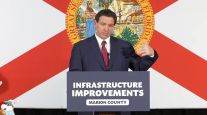Mica Set to Lead House Transportation & Infrastructure Panel
This story appears in the Nov. 8 print edition of Transport Topics.
The electoral wave that handed control of the House of Representatives to the Republicans also roiled the body’s transportation committee, ousting the panel’s current chairman and putting Rep. John Mica (R-Fla.) in position to lead the key committee.
The rising Republican tide rolled away the current chairman, Rep. James Oberstar, the Minnesota Democrat who has been a fixture on the Transportation and Infrastructure Committee since the 1970s.
Oberstar lost to Republican challenger Chip Cravaack.
Beyond Oberstar’s loss, the 75-member committee, which sets transportation policy in the House, will look drastically different, with analysts predicting that at least 20 members won’t be back.
The shift in the committee and in the overall political environment, observers said, clouds the outlook for the overdue reauthorization of the federal surface transportation program.
In a post-election press conference, President Obama said he thought the newly divided government could work together on infrastructure investment.
“I think the proposal that I put forward with respect to infrastructure is one that historically we’ve had bipartisan agreement about,” he said. In September, and again in October, Obama proposed spending $50 billion on highways and other transportation projects as the start of a six-year program.
Mica, the presumptive chairman of the transportation and infrastructure committee, released a statement indicating he was committed to moving forward on a series of transportation spending bills, including highway reauthorization.
“Among my top legislative priorities,” he said, “will be passing a long-term federal highway and transit reauthorization, a long-overdue Federal Aviation Administration reauthorization, a new water resources measure and a long-term Coast Guard reauthorization.”
Mica also said his “primary focus will be improving employment and expanding economic opportunities, doing more with less, cutting red tape and removing impediments to creating jobs, speeding up the process by which infrastructure projects are approved and freeing up any infrastructure funding that’s been sitting idle.”
“Roughly a third of the Democratic members [of the committee] lost yesterday,” said Rod Nofziger, director of government affairs for the Owner-Operator Independent Drivers Association. “Add that to the some of the retirements and folks moving off the panel and Republicans on the panel, that makes for a dramatically different transportation committee next January.”
The top Democrat on the committee will appear be Rep. Nick Rahall (D-W.Va.), unless Rahall chooses to retain his place as the senior member of the Natural Resources Committee.
If Rahall, however, stays with the resources committee, Rep. Peter DeFazio of Oregon would take over as ranking member on transportation.
DeFazio is currently chairman of the highways and transit subcommittee, but that position is likely to be filled by Rep. James Duncan (R-Tenn.), who currently is the panel’s ranking minority member.
The two parties will formally set their committee rosters before the start of the next session of Congress early in 2011.
Opinions varied on what the changes could mean for transportation, and specifically the highway bill, with some analysts saying they believed the election improved chances for passage of reauthorization, while others thought the new Congress was unlikely to move a significant bill.
Gregory Cohen, president of the American Highway Users Alliance, said he felt “good about getting the bill, but if we’re going to do a bill and get it done, it has to be done in the first half of the year.”
“There is an opportunity here,” Cohen said. “This could be the only major domestic discretionary program to get much bipartisan support, if it is done right.”
The right way, Cohen said, would involve making the bill “conservative in some way,” by limiting earmarks and reducing diversion of funds away from roads to other projects.
Mike Robinson, director of legislative affairs for American Trucking Associations, said that if Obama, Rep. John Boehner, the probable new speaker of the House, and other congressional leaders “want to work together, an infrastructure bill that would put people to work would certainly be a great place to start.”
Dick Henderson, director of legislative affairs for the Commercial Vehicle Safety Alliance, said that even though many new House Republicans ran against government spending, they ultimately may support a highway bill.
“One of the reasons they’re here is the voters don’t feel enough had been done to create jobs . . . and the voters are still going to hold the new crowd responsible for improving the economy,” he said.
“There’s a number of ways you can look at this as being an acceptable type of spending program,” said Jeff Shoaf, senior executive director of government and public affairs for the Associated General Contractors of America.
Specifically, Shoaf pointed to the fact the spending and projects are controlled by state and local governments and that the program finances itself through a user fee and trust fund.
Despite that, some said the administration and the new Congress will be unsuccessful in crafting a bill, even 18 months after the expiration of the previous reauthorization.
“I don’t believe the chances of a highway bill getting finished in the 112th Congress have increased,” said OOIDA’s Nofziger. “The prospects for a bill have actually dimmed . . . because of the overall political environment.”
Robinson said the question of paying for a transportation bill was “still a political football” that could trip up the two sides.
Neil Gray, director of government affairs for the International Bridge, Tunnel and Turnpike Association, said the Republican House “bodes well for my guys” and the future of tolling and public-private partnerships.
“It is certainly not for any love of the mechanism, but what other tools are there that provide even a chance of providing something without going into hock, as it was with [the stimulus]?” he said.




